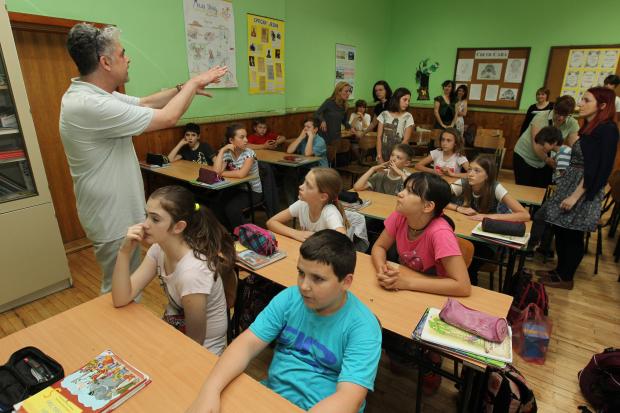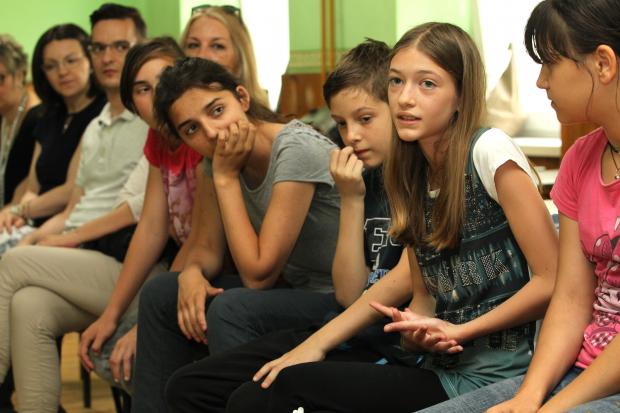Integration starts with a common language - Enhancing state language proficiency of national minority students in Serbia
Last May, a group of Serbian language experts visited an elementary school in Preševo, southern Serbia, where the main language of instruction is Albanian. The fifth-grade pupils staged a short welcome play. With great animation they recited long passages in Serbian, an impressive performance clearly carefully rehearsed with their teacher. But when the visitors proceeded to lead an interactive workshop with the children, asking them about their families, clothes, food and the weather, most of them struggled to answer even the most rudimentary questions in Serbian.
Serbian for non-native speakers
The experts were members of a working group established by the Institute for the Improvement of Education, tasked with drafting a new curriculum for teaching Serbian as a second language in minority-language schools. The OSCE Mission to Serbia which is supporting the project organized a tour for the drafters to schools all over the country, to see how the current approach is working. Scenes like the one in Preševo showed, time and again, that it is not.
In Serbia, members of national minorities have under certain conditions the right to education in their mother tongue, currently exercised in the languages of eight out of the 21 recognized national minorities: Albanian, Bosnian, Bulgarian, Croatian, Hungarian, Romanian, Ruthenian and Slovak. At the same time, Serbian is a mandatory subject of instruction as a second language, both in elementary and secondary schools. That makes a total of 12 years of instruction in Serbian. Yet many students graduate without having acquired even basic proficiency in the state language.

This was not always the case, explains Dejana Milijić-Subić, Advisor at the Institute for the Improvement of Education and Co-ordinator of the working group. “The practice of teaching Serbo-Croatian as a non-mother tongue emerged in this region shortly after the Second World War. It was strongly promoted at the time as a common language for the many nationalities living on the territory of the former Yugoslavia. However, after the break-up of the country and the ensuing conflicts, communities, especially Albanian and Hungarian ones, became more ethnically segregated. Although Serbian is still taught in schools, it is no longer considered important.”
Wrongly so, Subić argues. Not being able to function in the state language puts members of national minorities at a great disadvantage. “Due to their poor knowledge of Serbian, they are practically unable to exercise their civil rights and responsibilities,” she says. They experience difficulties when trying to enroll in a university or apply for a job. Many see no future for themselves in the country, like the group of Hungarian-speaking secondary students the language experts encountered in Subotica, who, when asked about their plans after graduation, all spoke of going to Hungary to work or to study.
Willingness to learn
In spite of the alarming lack of proficiency the experts encountered, their observations were encouraging on one count – perhaps the most important. The children harboured no prejudice against learning Serbian. They participated in the interactive language games and exercises with enthusiasm. Their poor command of the language was attributable to lack of opportunity to practice, not to aversion.

Vesna Weiss, the principal of the Hungarian-language Secenyi Istvan Elementary School in Subotica, pointed to two obstacles preventing teachers of Serbian from helping pupils progress as well as they might, both of which a new curriculum and teaching tools could rectify.
“Firstly, the current curriculum does not cater to the children’s needs to learn practical conversation skills. That means teachers have to improvise. But often, especially as Serbian is frequently taught by teachers not specialized in the methodology of language teaching, they simply become disheartened and lose interest,” she said.

“Secondly,” she continued, “textbooks are the same for all national minorities regardless of the language group to which their mother tongue belongs. But it is far easier for a student who speaks a Slavic language like Croatian or Slovakian to master Serbian than it is for ethnic Hungarians or Albanians, especially if they live in an insular mono-ethnic community.”
A two-level curriculum
Based on these insights, the working group has decided to create a two-level curriculum for Serbian as a second language, each with its own set of learning outcomes. A basic level will focus on acquiring conversational language skills, thus enabling easier integration into the community. An advanced level, aimed at Slavic language speakers, will furthermore include elements of Serbian literature and culture.
The Mission to Serbia will continue to support the improvement of the teaching of the state language in the host country. So that all citizens of Serbia can integrate into public life as equal members of society.

